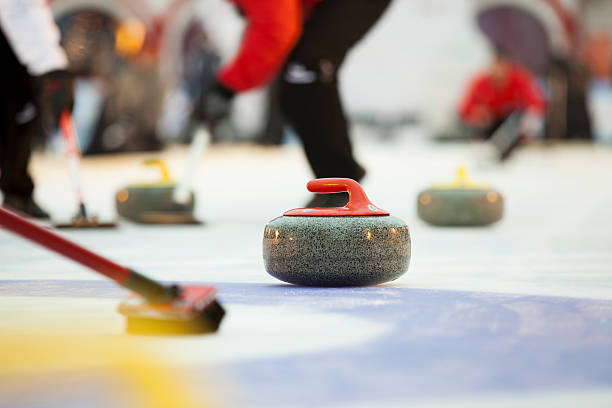Curling's Hidden Depths: The Cerebral Sport on Ice
Sliding stones, furious sweeping, and strategic plays unfold on a sheet of ice. Welcome to the world of curling, a sport that blends physical precision with chess-like strategy. Often misunderstood and underestimated, curling has evolved from a Scottish pastime to an Olympic sensation, captivating audiences with its unique blend of finesse, teamwork, and tactical brilliance.

The Origins and Evolution of Curling
Curling’s roots stretch back to 16th century Scotland, where the game was played on frozen lochs and ponds. Early curlers used smooth river stones, a far cry from the precisely crafted granite stones used today. The sport’s name derives from the distinctive curl or spin imparted to the stone as it’s released, a technique that adds layers of complexity to the game.
As Scottish immigrants spread across the globe, they took curling with them, particularly to Canada, where the sport found fertile ground. The harsh Canadian winters provided ideal conditions for curling, and the sport quickly became ingrained in the country’s cultural fabric. Today, Canada remains a powerhouse in international curling competitions.
The sport’s evolution has been marked by technological advancements and rule refinements. The introduction of indoor rinks in the 20th century allowed for more consistent ice conditions, while improvements in stone and broom design have enhanced players’ ability to control the game. The adoption of curling as an official Olympic sport in 1998 marked a significant milestone, bringing global attention and prestige to this once-niche activity.
The Physics of Curling: Where Science Meets Sport
At its core, curling is a game of physics. The interplay between the stone, the ice, and the sweepers’ brooms creates a fascinating display of scientific principles in action. The key to curling lies in understanding and manipulating these physical forces to achieve the desired outcome.
The curling stone, weighing between 38 and 44 pounds, is made of a specific type of granite found only on Scotland’s Ailsa Craig. Its unique shape, with a flat sliding surface and a handle on top, allows for precise control during delivery. As the stone slides down the ice, it encounters two opposing forces: friction, which slows it down, and curl, which causes it to curve.
The curl is created by a phenomenon known as asymmetrical friction. As the stone rotates, its front edge experiences more friction than its back edge, causing it to curve in the direction of rotation. This is where the sweepers come in. By vigorously brushing the ice in front of the stone, they can reduce friction and influence its path and speed.
The ice itself is a crucial factor in curling. Unlike the smooth surface used in skating, curling ice is deliberately textured or “pebbled” with tiny water droplets. This pebbling reduces the contact area between the stone and the ice, allowing for greater control and longer slides.
Strategy and Tactics: The Chess of Winter Sports
While the physics of curling are fascinating, it’s the strategic depth of the game that truly sets it apart. Often described as “chess on ice,” curling requires players to think several moves ahead, anticipating their opponent’s plays and setting up complex shot combinations.
A curling match consists of multiple “ends,” similar to innings in baseball. In each end, teams alternate throwing eight stones each, aiming to place their stones closest to the center of the target area, known as the “house.” The strategy involves not just placing your own stones well, but also removing or blocking your opponent’s stones.
Different types of shots serve various strategic purposes. A “draw” shot aims to stop in a specific location, while a “takeout” is designed to remove an opponent’s stone from play. The “guard” shot places a stone in front of the house to protect scoring stones, and the “freeze” nestles a stone right up against another to make it difficult to remove.
Team communication is crucial in executing these strategies. The skip, or team captain, calls the shots and directs the sweepers. The sweepers, in turn, must judge the weight and line of the stone, communicating this information back to the skip. This constant flow of information and decision-making under pressure adds to the mental challenge of the sport.
The Physical Demands of Curling
While curling may not have the obvious athleticism of sports like basketball or soccer, it places unique physical demands on its players. The delivery of the stone requires strength, balance, and flexibility. Players must slide on one foot while pushing off with the other, all while maintaining perfect form to ensure an accurate release.
Sweeping, perhaps the most recognizable aspect of curling, is an intense cardiovascular workout. Sweepers may cover up to two miles in a single game, moving rapidly up and down the ice while vigorously brushing. This action requires not just endurance, but also upper body strength and the ability to apply significant downward pressure on the broom.
The repetitive nature of these movements, combined with the cold environment, puts curlers at risk for various injuries. Common issues include knee and back problems from the delivery stance, shoulder injuries from sweeping, and general muscle strains. As a result, many competitive curlers engage in year-round fitness regimens to build strength, flexibility, and endurance.
The Culture and Community of Curling
Beyond the technical aspects of the sport, curling is known for its strong sense of community and sportsmanship. The “Spirit of Curling,” a set of unwritten rules that emphasize fair play and mutual respect, is deeply ingrained in the sport’s culture. It’s common for opposing teams to socialize before and after matches, a tradition known as “broomstacking.”
This welcoming atmosphere extends to new players as well. Many curling clubs offer “Learn to Curl” programs, making the sport accessible to people of all ages and abilities. The inclusive nature of curling has contributed to its growing popularity, with clubs popping up in unexpected places, from the deserts of Arizona to the tropical climate of Hawaii.
Curling has also embraced technology and social media, helping to broaden its appeal. Live streaming of matches, interactive analytics, and behind-the-scenes content have all helped to demystify the sport and engage new fans. The quirky nature of curling, with its unique terminology and passionate fanbase, has made it a favorite subject for memes and social media trends during the Winter Olympics.
The Future of Curling: Innovations and Challenges
As curling continues to grow in popularity, it faces both opportunities and challenges. On the innovation front, new technologies are being developed to enhance the sport. Sensors embedded in stones and brooms can provide real-time data on stone speed, curl, and sweeping effectiveness, offering valuable insights for players and coaches.
There’s also a push to make curling more environmentally sustainable. Traditional curling requires significant energy to maintain the ice, leading some facilities to explore more efficient cooling systems and even the possibility of synthetic ice for practice.
However, curling also faces challenges. The sport’s growth in non-traditional markets is hampered by the need for specialized facilities. There’s also an ongoing debate about the balance between tradition and innovation, particularly regarding equipment regulations.
Despite these challenges, the future of curling looks bright. Its combination of strategy, skill, and sportsmanship continues to attract new players and fans. As the sport evolves, it maintains its core appeal: a game that anyone can learn, but that takes a lifetime to master.
Curling’s Global Impact: Beyond the Ice
While curling may have its roots in Scotland and its stronghold in Canada, its influence now extends far beyond these traditional bastions. The sport’s inclusion in the Winter Olympics has sparked interest in countries not typically associated with winter sports. Nations like China, Japan, and South Korea have invested heavily in curling programs, achieving significant success on the international stage.
This global spread has led to a cross-pollination of styles and strategies. European teams, for instance, are known for their aggressive, high-risk play, while North American teams often favor a more conservative approach. As these different philosophies clash and blend, the sport continues to evolve, becoming more dynamic and unpredictable.
Curling’s growth has also had economic impacts. In Canada, where the sport is particularly popular, curling contributes significantly to the winter sports economy. Curling events draw tourists, create jobs, and stimulate local businesses. Even in non-traditional markets, the construction of curling facilities can serve as a catalyst for winter sports development and tourism.
The Mental Game: Psychology in Curling
While the physical aspects of curling are important, many argue that the mental game is where matches are truly won or lost. The precision required in curling, combined with the strategic complexity, places enormous psychological pressure on players.
Concentration and focus are crucial. A single lapse in attention can result in a poorly thrown stone, potentially changing the entire course of a match. Players must maintain this focus over long periods, with championship matches lasting up to three hours.
Decision-making under pressure is another key mental aspect of curling. Skips, in particular, must quickly analyze complex scenarios and make strategic choices. These decisions are often made with incomplete information, as factors like ice conditions can change throughout a match.
Team dynamics also play a crucial role. Unlike many team sports where players have distinct roles, in curling, each player takes turns throwing stones and sweeping. This requires a high level of trust and communication among teammates. Successful teams often speak of a near-telepathic understanding developed over years of playing together.
Many curling teams now work with sports psychologists to develop mental strategies for handling pressure, maintaining focus, and fostering team cohesion. Techniques like visualization, mindfulness, and cognitive restructuring are becoming increasingly common in high-level curling.
Curling and Gender Equality: A Level Playing Field
One of curling’s most notable aspects is its commitment to gender equality. Unlike many sports where men’s events receive more attention and resources, curling has long promoted equal opportunities for men and women. Mixed doubles, where teams consist of one male and one female player, has become increasingly popular and was added to the Olympic program in 2018.
This equality extends beyond the playing field. Women have held prominent roles in curling administration, coaching, and broadcasting. The sport’s governing bodies have made concerted efforts to ensure equal prize money and media coverage for men’s and women’s events.
The inclusive nature of curling also makes it accessible to people of all ages and physical abilities. It’s not uncommon to see teams with wide age ranges competing together, and the sport has been adapted for wheelchair users, allowing for truly integrated competition.
This commitment to equality and inclusion sets curling apart in the sporting world and contributes to its growing appeal. It offers a model for how other sports might approach issues of gender equality and inclusivity.
Conclusion: The Enduring Appeal of Curling
As we’ve explored, curling is far more than just sliding stones across the ice. It’s a sport that combines physical skill, mental acuity, and strategic depth. It’s a game steeped in tradition yet constantly evolving. It’s a community that values sportsmanship and inclusivity as much as competition.
The appeal of curling lies in its layers of complexity. On the surface, it seems simple, even quirky. But dig deeper, and you find a sport that offers endless opportunities for mastery and innovation. Whether you’re drawn to the physics of stone and ice, the chess-like strategy, or the camaraderie of the curling community, there’s something in this sport for everyone.
As curling continues to grow and evolve, it maintains its core essence: a game that challenges the body and mind in equal measure, that fosters fair play and mutual respect, and that brings people together in the spirit of friendly competition. In a world that often seems divided, perhaps we could all learn something from the spirit of curling.





